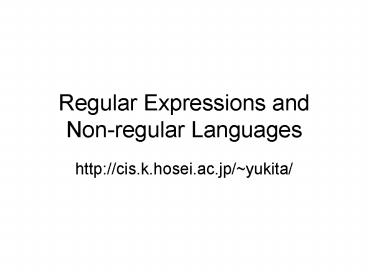Regular Expressions and Non-regular Languages PowerPoint PPT Presentation
Title: Regular Expressions and Non-regular Languages
1
Regular Expressions and Non-regular Languages
- http//cis.k.hosei.ac.jp/yukita/
2
Expressions and their values
3
Definition 1.26
4
The values of atomic expressions
5
Example 1.27
6
Units for the binary operations
7
Theorem 1.28
- A language is regular if and only if some regular
expression describes it. - We break down this theorem as follows.
- Lemma 1.29
- If a language is described by a regular
expression, then it is regular. - Lemma 1.32
- If a langulage is regular, then it is described
by a regular expression.
8
Proof of Lemma 1.29
a
Next three slides
9
Case 4 Let N1, N2, and N correspond to R1, R2,
and R, respectively.
N
N1
e
e
N2
10
Case 5 Let N1, N2, and N correspond to R1, R2,
and R, respectively.
N
e
e
11
Case 6 Let N1 and N correspond to R1 and R,
respectively.
N
e
e
e
12
Generalized Nondeterministic Finite Automaton
- is roughly a NFA in which the transition arrows
may have regular expressions as labels. - We assume the following standard form for
convenience, which can always be attained with an
easy modification. - There is only one accept state and different from
the start state. - The start state has transition arrows going to
every other state but no arrows coming in from
any other state. - There is only a single accept state, and it has
arrows coming in from any other state but no
arrows going to any other state. - Except for the start and accept states, one arrow
goes from every state to every other state and
also from each state to itself.
13
Standard Form of GNFA
...
14
Standard Form of GNFA
15
Equivalent GNFA with one fewer state
R4
qi
qj
qi
qj
R1
R3
qrip
R2
16
Definition 1.33
17
Computation with GNFA
18
Converting GNFA
19
Claim 1.34 For any GNFA G, Convert(G) is
equivalent to G.
20
Proof continued
21
Non-regularity
22
Theorem 1.37 Pumping Lemma
23
Proof of Th 1.37
24
Example 1.38
25
Example 1.39
26
Alternative proof of 1.39
27
Example 1.40
28
Example 1.41 Unary Language
29
Example 1.42 Pumping Down
30
Problem 1.41 Differential Encoding
0
1
1
0xx1
0xx0
0
0
qstart
0
1xx0
1xx1
1
1
1
0
PowerShow.com is a leading presentation sharing website. It has millions of presentations already uploaded and available with 1,000s more being uploaded by its users every day. Whatever your area of interest, here you’ll be able to find and view presentations you’ll love and possibly download. And, best of all, it is completely free and easy to use.
You might even have a presentation you’d like to share with others. If so, just upload it to PowerShow.com. We’ll convert it to an HTML5 slideshow that includes all the media types you’ve already added: audio, video, music, pictures, animations and transition effects. Then you can share it with your target audience as well as PowerShow.com’s millions of monthly visitors. And, again, it’s all free.
About the Developers
PowerShow.com is brought to you by CrystalGraphics, the award-winning developer and market-leading publisher of rich-media enhancement products for presentations. Our product offerings include millions of PowerPoint templates, diagrams, animated 3D characters and more.

